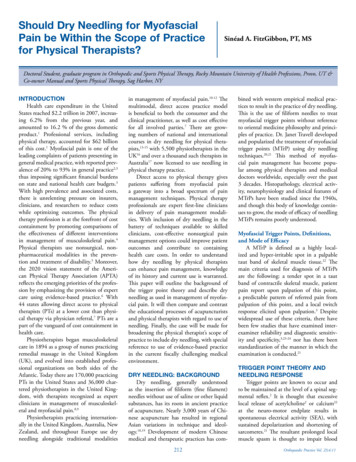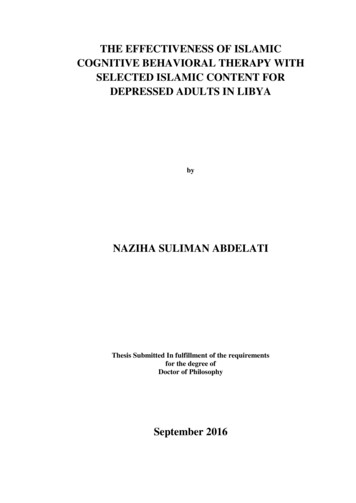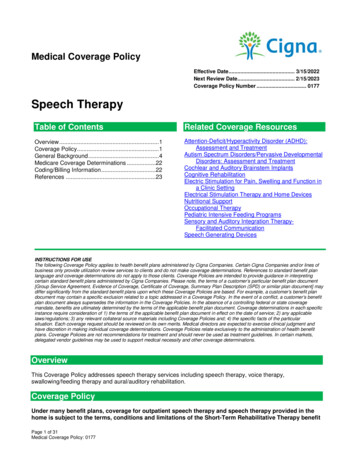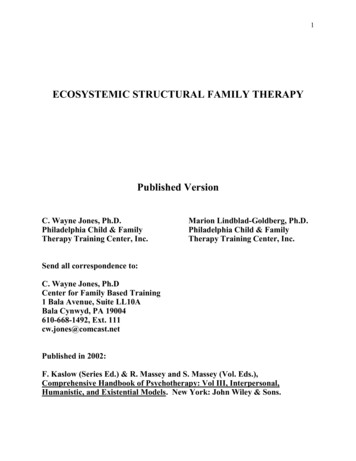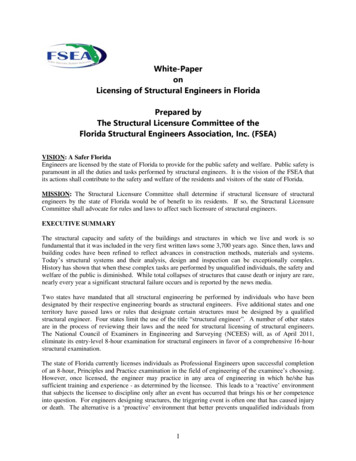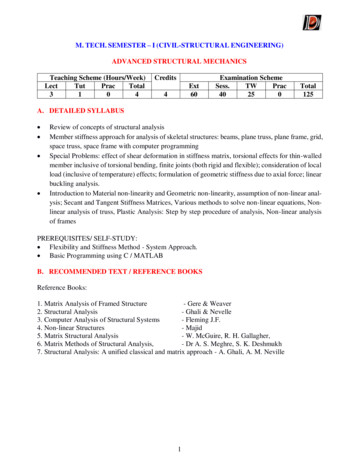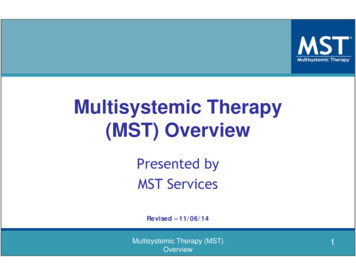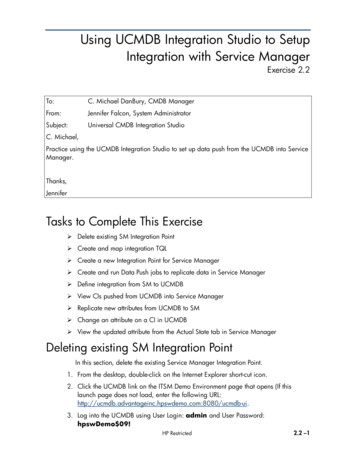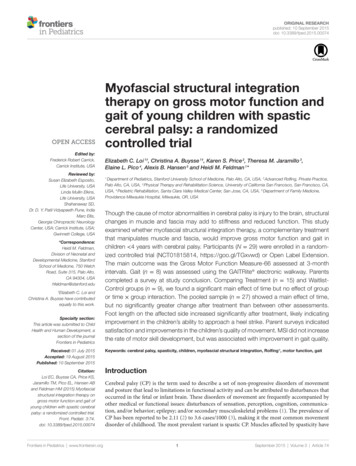
Transcription
Original Researchpublished: 10 September 2015doi: 10.3389/fped.2015.00074Myofascial structural integrationtherapy on gross motor function andgait of young children with spasticcerebral palsy: a randomizedcontrolled trialEdited by:Frederick Robert Carrick,Carrick Institute, USAReviewed by:Susan Elizabeth Esposito,Life University, USALinda Mullin Elkins,Life University, USAShahanawaz SD,Dr. D. Y. Patil Vidyapeeth Pune, IndiaMarc Ellis,Georgia Chiropractic NeurologyCenter, USA; Carrick Institute, USA;Gwinnett College, USA*Correspondence:Heidi M. Feldman,Division of Neonatal andDevelopmental Medicine, StanfordSchool of Medicine, 750 WelchRoad, Suite 315, Palo Alto,CA 94304, USAhfeldman@stanford.edu†Elizabeth C. Loi andChristina A. Buysse have contributedequally to this work.Specialty section:This article was submitted to ChildHealth and Human Development, asection of the journalFrontiers in PediatricsReceived: 01 July 2015Accepted: 19 August 2015Published: 10 September 2015Citation:Loi EC, Buysse CA, Price KS,Jaramillo TM, Pico EL, Hansen ABand Feldman HM (2015) Myofascialstructural integration therapy ongross motor function and gait ofyoung children with spastic cerebralpalsy: a randomized controlled trial.Front. Pediatr. 3:74.doi: 10.3389/fped.2015.00074Frontiers in Pediatrics www.frontiersin.orgElizabeth C. Loi 1†, Christina A. Buysse 1†, Karen S. Price 2, Theresa M. Jaramillo 3,Elaine L. Pico 4, Alexis B. Hansen 5 and Heidi M. Feldman 1*1Department of Pediatrics, Stanford University School of Medicine, Palo Alto, CA, USA, 2 Advanced Rolfing, Private Practice,Palo Alto, CA, USA, 3 Physical Therapy and Rehabilitation Science, University of California San Francisco, San Francisco, CA,USA, 4 Pediatric Rehabilitation, Santa Clara Valley Medical Center, San Jose, CA, USA, 5 Department of Family Medicine,Providence Milwaukie Hospital, Milwaukie, OR, USAThough the cause of motor abnormalities in cerebral palsy is injury to the brain, structuralchanges in muscle and fascia may add to stiffness and reduced function. This studyexamined whether myofascial structural integration therapy, a complementary treatmentthat manipulates muscle and fascia, would improve gross motor function and gait inchildren 4 years with cerebral palsy. Participants (N 29) were enrolled in a randomized controlled trial (NCT01815814, https://goo.gl/TGxvwd) or Open Label Extension.The main outcome was the Gross Motor Function Measure-66 assessed at 3-monthintervals. Gait (n 8) was assessed using the GAITRite electronic walkway. Parentscompleted a survey at study conclusion. Comparing Treatment (n 15) and WaitlistControl groups (n 9), we found a significant main effect of time but no effect of groupor time group interaction. The pooled sample (n 27) showed a main effect of time,but no significantly greater change after treatment than between other assessments.Foot length on the affected side increased significantly after treatment, likely indicatingimprovement in the children’s ability to approach a heel strike. Parent surveys indicatedsatisfaction and improvements in the children’s quality of movement. MSI did not increasethe rate of motor skill development, but was associated with improvement in gait quality.Keywords: cerebral palsy, spasticity, children, myofascial structural integration, Rolfing , motor function, gaitIntroductionCerebral palsy (CP) is the term used to describe a set of non-progressive disorders of movementand posture that lead to limitations in functional activity and can be attributed to disturbances thatoccurred in the fetal or infant brain. These disorders of movement are frequently accompanied byother medical or functional issues: disturbances of sensation, perception, cognition, communication, and/or behavior; epilepsy; and/or secondary musculoskeletal problems (1). The prevalence ofCP has been reported to be 2.11 (2) to 3.6 cases/1000 (3), making it the most common movementdisorder of childhood. The most prevalent variant is spastic CP. Muscles affected by spasticity have1September 2015 Volume 3 Article 74
Loi et al.Myofascial therapy in cerebral palsyincreased velocity-dependent sensitivity to stretch, causing stiffness, tightness, and interference with movement, which can leadto joint contracture and deformity. Children with mild forms ofspastic CP usually walk independently. Visual gait analysis hasidentified slower velocity, shorter stride length, and longer doublesupport time in ambulatory children with CP relative to typicallydeveloping peers (4).None of the common treatments for spastic CP, includingphysical and occupational therapy; bracing; medications; andsurgical procedures is completely satisfactory. Non-invasivetreatments often have limited or temporary treatment effects thatfail to substantially change the natural course of the condition orimprove an affected limb’s functional capacity (5, 6). Localizedtreatment with injections of botulinum toxin A is associated withonly temporary improvements in selected gait parameters andin reducing spasticity (7–10). Systematic reviews suggest that acombination of approaches may be more effective than a singleapproach to treatment (11).In the past, spasticity was attributed solely to the etiologicnon-progressive central nervous system injury. Recent evidencesuggests that skeletal muscle and its extracellular matrix arealtered in CP (12, 13). Increased passive stiffness within the muscle bundle is accompanied by increased collagen content withinthe extracellular matrix and by increased sarcomere length, ratherthan by abnormalities of the mechanical properties of individualmuscle fibers. These findings implicate structural changes in themuscle and extracellular matrix of muscle as important contributors to the increased muscle tone and stiffness in CP (14).Targeting the local structural changes, especially before thedevelopment of contractures and deformities, might, therefore,be a helpful component of a comprehensive strategy to improvemotor function in young children with CP. The goal of the presentstudy was to determine if a treatment that manipulated muscleand surrounding fascia, used as an adjunct to physical therapy,occupational therapy, and routine medical care, could improvemotor function and gait in young children with spastic CP.The treatment we assessed was myofascial structural integration (MSI). MSI is a specific manipulative and movement-basedcomplementary medicine practice, developed by Dr. Ida P. Rolfin the 1930s. In MSI, a trained practitioner manually manipulates muscle and fascia in order to free up stiff body parts andjoints, increase stability, improve balance and mobility, andput the body into proper alignment to facilitate improvedmotor patterns. This treatment was selected because its goalsare appropriate for children with CP, it follows a standard andreproducible 10-week protocol and it addresses the whole body,not just legs or arms. Previous research on MSI for individualswith CP found that patients with mild CP experienced improvements in such gait parameters as cadence, velocity, and stridelength after a standard course of treatment with MSI (15). Arecent preliminary randomized crossover design trial of MSI inyoung children with CP showed greater improvements after acourse of MSI than after a comparable number of control playsessions, though some children improved throughout the entirestudy (16). A case report found improvements in cadence anddouble support time in two children with spastic CP after MSI(17). MSI is distinct from massage, another movement-basedFrontiers in Pediatrics www.frontiersin.orgcomplementary practice, which has been shown to have variableeffects on adolescents with CP (18).The primary aim of this study was to determine whether MSItherapy, used as an adjunct to physical and occupational therapy,could improve gross motor function in young children with spastic CP. We hypothesized that a course of MSI treatment added tothe existing regimen of physical and occupational therapy wouldlead to greater gains in gross motor function than the therapiesalone. A secondary aim of the study was to evaluate changes toselect gait parameters after the treatment in those children whowere ambulatory at the time of Enrollment. The final aim was toobtain parental impressions of the MSI treatment and its impacton the children after treatment. Though MSI is a non-invasiveapproach, we surveyed families after the treatment to determine ifthere were any adverse effects and to learn if parents saw benefitsthat were not captured in our assessments.If MSI were to prove effective, it could be incorporated into thetreatment plan of young children with spastic CP as an adjunctto conventional therapies. Ideally, it would delay or eliminatethe need for risky, invasive, or time-limited treatment options.Because it is safe, it could also be used repeatedly across the child’sdevelopment. It is important to prove efficacy because thoughsafe, the standard course of 10 sessions may not be reimbursedby health insurance and is, therefore, expensive for families.Materials and MethodsParticipantsYoung children with spastic CP were recruited from a universitymedical clinic, state-funded medical therapy programs that servechildren with CP, and through self-referral from local publicity.We studied young children, less than age 48 months at the timethat consent was obtained because they are in a dynamic period ofdevelopment, generally before the onset of deformities and contractures, and therefore possibly more likely to change than olderchildren or adults. Eligibility criteria were as follows: diagnosisof spastic CP (or mixed CP with spasticity); no recent history ofseizures, surgery, or botulinum toxin A injections; receiving physical therapy; and level II, III, or IV on the Gross Motor FunctionClassification System (GMFCS) or a level of II, III, IV on the ManualAbility Classification System (MACS) for children who wereGMFCS I, as determined by a physical therapist or pediatricianon the study team. Throughout the study, the children continuedto participate in their typical treatment regimen, which includedphysical therapy at minimum and depending on the child, mayhave also included occupational therapy, medications, other complementary treatments (e.g., Feldenkrais Method), and regularrecreational activities (e.g., swimming). The Institutional ReviewBoard at Stanford University approved the protocol and parentsprovided informed consent prior to their child’s participation.Study DesignThe study was conducted in two phases. Phase 1 was a randomized controlled trial (RCT). We enrolled 26 children in theRandomized Cohort on a rolling basis and assigned them toone of the two groups through the use of a random numbersorter: Treatment (n 13) or Waitlist-Control Group (n 13)2September 2015 Volume 3 Article 74
Loi et al.Myofascial therapy in cerebral palsy(Figure 1). Two children, one from each group, did not completethe treatment protocol and were dropped from further analyses.Three children originally assigned to the Waitlist-Control Groupwere reassigned to the Treatment Group to accommodate thechildren’s circumstances: one to complete the treatment protocolbefore the anticipated birth of a sibling, one to avoid delay inphysician-prescribed botulinum toxin A injections, and one toavoid further waiting for a child whose participation was delayedwhile she enrolled in a physical therapy program. The revisedsample size in the Randomized Cohort was Treatment Groupn 15 children and Waitlist-Control Group n 9.Phase 2 was an Open Label Extension. Children randomizedto the Waitlist-Control Group received the treatment after thewait period. In addition, funding permitted the enrollment of fiveadditional children (“Non-Randomized Cohort”), all of whomwere assigned to the Treatment Group in order to complete theprotocol before the end of the funding period. We then comparedthe Treatment Group (n 20) to the Waitlist-Control Group(n 9). We also evaluated the pooled sample (n 27) for changeover time.All of the participants were scheduled for an evaluation atEnrollment and every 3 months for a total participation periodof 9 months. Figure 2 shows the stages of the study. All of thechildren waited 3 months and had a second assessment prior toMSI treatment in order for us to assess the rate of developmentalchange prior to the experimental treatment. The second assessment was called the Pre-Treatment Assessment for the TreatmentGroup and the Wait Assessment for the Waitlist-Control Group(Figure 2). The Treatment Group underwent MSI therapybetween the second and third assessments. The Waitlist-ControlGroup began MSI therapy after the third assessment. Both groupshad a Post-Treatment Assessment and the Treatment Groupwas also assessed at a 3-month Maintenance assessment. Allparticipants completed at least three assessments, including thepost-treatment assessment, and 27 of the 29 children completedfour assessments (one moved away from the geographic areabefore study completion and one began therapy with botulinumtoxin A injections), to show whether skills remained stable duringmaintenance for the Treatment Group.TreatmentEach child was scheduled for 10 weekly 60- to 90-min sessionsof the MSI intervention. All of the children completed 9 or 10 ofthe scheduled sessions. A single Certified Advanced Rolfer (KSP)with over 35 years of experience working with young childrenprovided the therapy in her private studio. MSI treatments followed the specific, structured sequence that addressed the entirebody. The researchers prepared the parents and the children byexplaining the therapy as a type of bodywork similar to deeptissue massage. Children remained partially clothed and lay ona table, sat on the floor, or sat on a parent’s lap during the treatment. During each session, the clinician manually manipulatedthe muscles and fascia of the section of the body that was thefocus for that day.Primary Outcome Measure: The Gross MotorFunction Measure-66An assessor (physical therapist or pediatrician) blind to eachchild’s group assignment completed the Gross Motor FunctionMeasure-66 (GMFM-66). The GMFM-66 is an observationalmeasure that was developed to capture the gross motor capacityof children with CP. It is has been shown to be valid, reliable, andresponsive to change (19). The 66-item tool utilizes a 0–3 ratingscale to measure skills in five different dimensions (A: Lying andFIGURE 1 Study group assignment: original randomization group assignments in the Randomized Cohort, subsequent shifts, and addition of theNon-Randomized Cohort.Frontiers in Pediatrics www.frontiersin.org3September 2015 Volume 3 Article 74
Loi et al.Myofascial therapy in cerebral palsyFIGURE 2 Study design: assessment points and treatment periods for the Treatment and Waitlist-Control groups.Rolling, B: Sitting, C: Crawling and Kneeling, D: Standing, and E:Walking, Running, and Jumping). The total score, between 0 and100 (higher scores indicating greater function), is obtained usingspecialized program scoring software that is based on a logit scale.Each assessment was videotaped and scored. After the conclusionof the study, videos for participants who demonstrated irregularscore patterns were reviewed and their corresponding GMFMsrescored if required.body control, balance/flexibility, strength, height, weight, andfunctional achievements. The 11-question survey included openresponse questions, such as, “Did you notice any changes in yourchild’s balance/flexibility (walking, standing, climbing stairs, tripping)?” and “Did you notice any changes in your child’s strength(self support, pulling up, climbing)?” The survey also includedtwo ratings of satisfaction: “Parent Rating of Satisfaction” and“Parent Rating of Child Satisfaction.” Each rating was recordedon a Likert Scale, with 1 as the lowest score and 10 as the highestscore.Secondary Outcome Measure: GAITRite Electronic WalkwayData AnalysisPrimary AnalysisGait assessments of all ambulatory children were recorded andanalyzed using the GAITRite electronic walkway. Its ease ofoperation makes this 14-foot walkway suitable for use withchildren. Several studies have documented the reliability ofthe measures in children with CP (20–22). As a child traversesthe GAITRite walkway, pressure exerted by foot contact on thesurface activates sensor pads embedded in the electronic mat. Thewalkway records the geometry of the activating foot contact andthe relative arrangement of contact points in two-dimensionalspace. Spatial and temporal characteristics of the gait are calculated based on foot contact geometry.Children walked barefoot over the walkway at a self-selectedpace. Multiple passes over the walkway were obtained at eachassessment. For analysis, a Walk was defined as the averageddata of the first two and up to four passes over the walkway thatincluded a minimum of eight fluent steps in one direction acrossthe mat with one foot always on the mat (indicating a walkingpace). Passes in which the participants ran, stopped, or navigatedoff the mat were excluded.Analyses were conducted using SPSS version 22. As preliminaryanalyses, we first compared the Treatment and Waitlist-Controlgroups from the Randomized Cohort using independent-samplest-tests and Fisher’s Exact Test to establish if the groups were comparable on the basis of mean age, gender, race (comparing Whiteto Non-White), CP type (comparing hemiparesis diagnosis tonon-hemiparesis diagnosis), CP severity (comparing GMFCSlevels I and II to III and IV), and mean GMFM-66 score atEnrollment. To assess treatment efficacy within the RandomizedCohort, we used a Repeated Measures ANOVA; GMFM scoresat assessments II and III (Pre-Treatment to Post-Treatment forthe Treatment Group and Wait Assessment to Pre-Treatment forthe Waitlist-Control Group) were the within subject variables andrandomization group was the between subject variable.In the Open Label Extension, we compared the five childrenin the Non-Randomized Cohort to the group of 24 children inthe Randomized Cohort using independent-samples t-tests andFisher’s Exact Test to ensure that the groups remained comparable in composition on the same metrics as mentioned above.We then compared the expanded Treatment Group (n 20) tothe Waitlist-Control Group (n 9) using Repeated MeasuresANOVA, following the same strategy as in the RCT.In order to examine whether there were time by group interactions at any point during the study, we completed the RepeatedMeasures ANOVA on the pooled sample of children who completed all four assessments (n 27). For this analysis, GMFMSecondary Outcome Measure: ParentSatisfaction SurveyAt the conclusion of the study, parents were given a “ParentSatisfaction Survey” that the research team developed to recordparents’ impressions of changes they saw in their children overthe course of the study. The survey also allowed parents toprovide feedback to the researchers about the study in general.The survey included the domains of emotional affect, functionalFrontiers in Pediatrics www.frontiersin.org4September 2015 Volume 3 Article 74
Loi et al.Myofascial therapy in cerebral palsyscores at assessments I–IV were the within group variable andrandomization group was the between group variable.TABLE 1 Demographic and clinical information on participants.RandomizedCohortSecondary AnalysesWaitlistControl (n 9)For the secondary gait analysis, we selected a small set of dependent variables that captured different aspects of gait from the manyinter-related measures that the GAITRite walkway generates, asfollows: foot length and foot width, derived from the length andwidth of sensors activated by foot pressure progressing along themat, and stride length, defined as the forward-progressing linebetween the heel points of two consecutive footprints of the samefoot. Selected temporal parameters were as follows: double support time, defined as the percent of the gait cycle spent with bothfeet on the mat, and velocity, defined as distance traveled dividedby ambulation time (23). Paired samples t-tests were performed tocompare Pre-Treatment to Post-Treatment measurements. Whendifferences were noted, paired t-tests were used to determine ifdifferences were present between the assessment immediatelyprior to the Pre-Treatment Assessment (Enrollment for theTreatment Group and Wait Assessment for the Waitlist-ControlGroup) and Pre-Treatment and also between Post-Treatment andMaintenance Assessments.For the Parent Satisfaction Survey, the mean scores for the twoLikert scales of “Parent Rating of Satisfaction” and “Parent Ratingof Child Satisfaction” were calculated from all available responses.Treatmenta(n 15)Treatmentb(n 5)Mean age, years (SD) 2.2 (0.8)Male, % (n)55.6 (5)Non-White, % (n)44.4 (4)2.4 (1.0)40.0 (6)26.7 (4)2.1 (0.7)20.0 (1)60.0 (3)Type of spasticcerebral palsy, % (n)Hemiparesis:44.4 (4)Diplegia: 0.0 (0)Quadriparesis:55.6 (5)Hemiparesis:33.3 (5)Diplegia: 20.0 (3)Quadriparesis:46.7 (7)Hemiparesis:60.0 (3)Diplegia: 0.0 (0)Quadriparesis:40.0 (2)Gross MotorFunctionClassification Systemlevel, % (n)Level 1: 11.1 (1)Manual abilityClassificationSystemLevel 2: n 0Level 3: n 1Level 4: n 0Level 2: 33.3 (3)Level 3: 0.0 (0)Level 4: 55.6 (5)Level 1: 20.0 (3)Manual abilityClassificationSystemLevel 2: n 1Level 3: n 2Level 4: n 0Level 2: 26.7 (4)Level 3: 20.0 (3)Level 4: 33.3 (5)Level 1: 40.0 (2)Manual abilityClassificationSystemLevel 2: n 0Level 3: n 1Level 4: n 1Level 2: 20.0 (1)Level 3: 0.0 (0)Level 4: 40.0 (2)40.6 (14.7)40.3 (17.7)37.9 (19.8)Mean Gross MotorFunction Measure-66score at Enrollment(SD)aDifferences between Waitlist-Control and Treatment groups within the RandomizedCohort were not statistically different.bDifferences between the Randomized and Non-Randomized cohorts were notstatistically different.ResultsRandomized Controlled TrialTable 1 shows demographic and clinical characteristics ofthe children in the RCT. Within the Randomized Cohort, theTreatment Group (n 15) did not differ from the Waitlist-ControlGroup (n 9) in terms of mean age, gender, race, CP type, CPseverity as measured by the GMFCS, and mean GMFM-66 scoreat Enrollment.The critical assessment of the efficacy of MSI treatment waschange in GMFM scores between assessments II and III. Therewas a significant effect of time F(1, 22) 8.096, p 0.009, butno significant effect of group F(1, 22) 0.394, p 0.537 and nosignificant time by group interaction F(1, 22) 0.911, p 0.350.Test indicated that the assumption of sphericity had been violatedfor the main effects of time, x2(5) 23.458, p 0.000. Thus, weused the Greenhouse–Geisser correction for degrees of freedom(ϵ 0.615). There was a significant effect of time, F(1.845,46.114) 18.324, p 0.000, but no significant effect of group, F(1,25) 0.090, p 0.767 and no time by group interaction, F(1.845,46.114) 0.866, p 0.420. Figure 4 shows the change across thefour assessments for the two groups in the pooled sample.Secondary Results: Gait ParametersTable 2 includes the mean values for the Pre-Treatment andPost-Treatment Assessments for each measure in comparisonto normative data for children of comparable ages on thosemeasures (22, 24). Two spatial parameters, foot width and stridelength, and both temporal parameters were unchanged beforeand after treatment.Foot length on the more affected side increased significantlyfor the pooled sample between the Pre-Treatment and PostTreatment intervals (M 12.1, SD 2.03) and (M 12.59,SD 2.32), p 0.04. Figure 5 shows foot length of the more affectedfoot in study participants over time, with normative foot size forchildren in this age group referenced (24). Subsequent analysesfound that foot length did not change between the assessmentprior to Pre-Treatment (Enrollment for the Treatment Group andWait Assessment for the Waitlist-Control Group) and the PreTreatment Assessment (M 12.04, SD 2.23) and (M 12.1,SD 2.03), p 0.76 and were maintained at MaintenanceOpen Label ExtensionTable 1 documents that the five additional participants who constituted the Non-Randomized Cohort did not differ significantlyfrom the group of randomized participants in terms of mean age,gender, race, CP type, severity of CP as measured by the GMFCS,and mean GMFM-66 score at Enrollment.With the larger sample (N 29), the comparison of changein scores for the Treatment Group and for the Waitlist-ControlGroup from assessment II to III found a main effect of time F(1,27) 9.786, p 0.004 but no effect of group F(1, 27) 0.435,p 0.515 or time by group interaction F(1, 27) 1.349, p 0.256.Figure 3 shows the estimated marginal mean scores for theGMFM assessments at the two time points.The pooled sample that underwent four assessments (n 27)was used to detect any differences in rate of change between thetwo groups from Enrollment to the final assessment. Mauchly’sFrontiers in Pediatrics www.frontiersin.orgNon-RandomizedCohort5September 2015 Volume 3 Article 74
Loi et al.Myofascial therapy in cerebral palsyFIGURE 3 Estimated marginal means on the Gross Motor FunctionMeasure-66 (GMFM-66) from Assessment II to Assessment III for thepooled sample. (Assessment II is the Pre-Treatment Assessment for theTreatment Group and the Wait Assessment for the Waitlist-Control Group.Assessment III is the Post-Treatment Assessment for the Treatment Groupand the Pre-Treatment Assessment for the Waitlist-Control Group.)FIGURE 4 Estimated marginal means on Gross Motor FunctionMeasure-66 (GMFM-66) from Assessments I through IV for the pooledsample. (Assessment I is the Enrollment Assessment for both groups.Assessment II is the Pre-Treatment Assessment for the Treatment Group andthe Wait Assessment for the Waitlist-Control Group. Assessment III is thePost-Treatment Assessment for the Treatment Group and the Pre-TreatmentAssessment for the Waitlist-Control Group. Assessment IV is theMaintenance Assessment for the Treatment Group and the Post-TreatmentAssessment for the Waitlist-Control Group.)(M 12.8, SD 2.35), p 0.40. As shown in Figure 5, the effectwas greatest in the children with hemiplegia; the change betweenPre-Treatment and Post-Treatment for these seven children wassignificant (M 11.86, SD 2.06) and (M 12.46, SD 2.48),p 0.02.TABLE 2 Mean gait parameters on more affected side in relation tonormative data for ambulatory children with CP.ParameterSecondary Results: Parent Satisfaction SurveyParents of 25 of the 29 participants (86%) completed the ParentSurvey. The mean “Parent Rating of Satisfaction” was high at8.4/10 (minimum 3.0, maximum 10.0, SD 1.9). The“Parent Rating of Child Satisfaction” was high at 8.6/10.0 (minimum 3.0, maximum 10.0, SD 1.8).Many parents reported observed qualitative improvements intheir children’s gross motor skills. One parent wrote that her childexperienced “improved walking, climbing stairs, sitting on floorcross-legged, decreased limp.” Another parent noticed that herchild held his “left hand less fisted.” A common comment wasthat the children enjoyed the massage. One parent said, “It feltso good to him like massage.” Another exclaimed, “Rolfing – sheloved it! And we saw many gains during therapy.” Changes werealso noted in subjective well-being and quality of life, such as“improved mood.” One parent reported that her child had a“more relaxed demeanor[,] improved sleep[, and was] calmerfor longer periods of time.” Another parent concluded hersurvey by writing, “We will do it again in the future.”Frontiers in Pediatrics www.frontiersin.orgNormativedata mean(SD)Foot length (cm)16.0 (2.52)Foot width (cm)7.0 (2.11)Stride length (cm)68.8 (14.55)Double support16.5 (5.0)time (% gait cycle)Velocity (cm/s)101.1 (29.9)PreTreatmentmean (SD)PostTreatmentmean (SD)tp12.1 (2.03)5.8 (1.33)62.8 (6.52)21.9 (4.40)12.6 (2.32)6.1 (1.48)64.1 (7.68)20.1 (5.24) 2.54 0.98 0.500.950.040.360.630.3884.1 (11.40)86.6 (14.51) 0.470.65DiscussionSummary of ResultsThe aim of this study was to investigate the effect of MSI therapyon the gross motor function and gait of young children with CP.The results of both the RCT and Open Label Extension showedthat the children improved in gross motor function over time,but the rate of improvement on this measure was no greaterimmediately after treatment than with developmental changealone. Analyses of spatial and temporal gait parameters using6September 2015 Volume 3 Article 74
Loi et al.Myofascial therapy in cerebral palsyFIGURE 5 Foot length on the more affected side of ambulatory participants with CP.an electronic walkway revealed changes in foot length, possiblyrepresenting improved heel strike, on the more affected side butno changes in the other gait parameters. A parent survey at theconclusion of the study found that parents were generally verysatisfied with the treatment and saw improvements in their children’s function that were not detected by the selected outcomesmeasures. In summary, in this sample of children with CP, MSIdid not increase the rate of motor skill development, but wasassociated with an improvement in gait quality and with positiveparent reports of changes.Why might the GMFM fail to register change as a result oftherapy in our study population? The assessment requires cooperation from the children during testing. Young children withCP may be inconsistent in their behavior and motivation and,therefore, inconsistent in their performance on the measure. Inthis study, most children showed consistent improvement in theirGMFM-66 score. However, occasionally, children experienced areduction in their scores from session to session. Many factors,such as mood, sleep disturbance, and level of cooperation, maycontribute to the variability in scores (36). For children who areeither at the floor or the ceiling of the skills that the GMFM isable to
examined whether myofascial structural integration therapy, a complementary treatment that manipulates muscle and fascia, would improve gross motor function and gait in children 4 years with cerebral palsy. Participants ( N 29) were enrolled in a random - ized controlled trial (NCT01815814, https://goo.gl/TGxvwd) or Open Label Extension.
